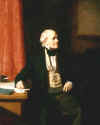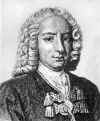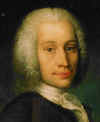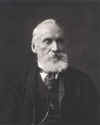| Guillaume
Amontons (1663
– 1705) was a French scientific instrument inventor and
physicist. He was one of the pioneers in tribology,
along with Leonardo da Vinci, John Theophilus Desaguliers,
Leonhard Euler, and Charles-Augustin de Coulomb. Birthday:
August 31, 1663 |
 |
Sir
Francis Beaufort (1774
– 1857) was an Irish born hydrographer and
officer in Britain's Royal Navy. Beaufort was the creator of the
Beaufort scale for indicating wind force. Birthday: May 27, 1774 |
 |
Daniel
Bernoulli (1700
– 1782) formulated what is known today as Bernoulli’s theorem.
This principle states that, in a flowing stream, the sum of a
fluid’s static energy, kinetic energy, and potential energy is
conserved across a constriction in the pipe. Birthday:
January 29, 1700
|
 |
Robert
Boyle (1627
– 1691) is regarded by many as the first modern chemist. He
formulated the law that the volume of a gas varies inversely with
pressure during an exchange with Franciscus Linus, a Jesuit
critic. This principle is now known as Boyle’s Law. He worked
with Robert Hooke to improve the air pump, and did experiments
with the properties of air. Birthday:
January 25, 1627 |
 |
Sir
James Chadwick, (1891 – 1974)
was an English Nobel laureate in physics awarded for his discovery
of the neutron. Birthday:
October 20, 1891 |
 |
Anders
Celsius (1701
– 1744) is known in the history of temperature for proposing the
Celsius temperature scale. This scale originally had 0 for the
boiling point of water and 100 for the freezing point. The scale
was later reversed to the form it has today. Birthday:
November 27, 1701 |
 |
Gaspard-Gustave
Coriolis (1792
– 1843) is well known for his work on the Coriolis effect. The
Coriolis effect forms the basis for the operation of Coriolis
flowmeters today. He was also the first person to apply the term
“work” to the product of force and distance. Birthday: May 21,
1792 |
 |
John
Dalton (1766
– 1844) is best known for his early work on and statement of
atomic theory. He kept a meteorological diary for 57 years, and
published a book of essays on his meteorological observations. He
is also known for his research into color blindness. Birthday:
September 6, 1766
|
 |
Rene
Descartes (1596
– 1650) is known as “the father of modern philosophy.” In
mathematics, he invented the Cartesian coordinate system and
analytic geometry. His most famous statement was “I think,
therefore I am.” |
 |
Christian
Doppler (1803
– 1853) is known for proposing what is today called the Doppler
effect. This has to do with the apparent change in wavelength and
frequency of a wave perceived by the observer to be moving
relative to the wave source.
The Doppler effect is the principle that
underlies the operation of today’s Doppler flowmeters. Birthday:
November 29, 1803 |
 |
Albert
Einstein (1879
– 1955) is considered by many to be one of the greatest
physicists of all time. He is best known for his theory of
relativity, but also made major contributions to quantum theory
and statistical mechanics. Einstein was born in Germany, but in
the 1930s was granted permanent residence in the United States. He
became an American citizen in 1940. |
| Daniel
Gabriel Fahrenheit (1686
– 1736) was a German physicist and engineer who determined a
temperature scale now named after him. Birthday:
May 24, 1686 |
 |
Michael
Faraday (1791
– 1867) is best known in the history of flow for formulating
Faraday’s Law of Electromagnetic Induction. According to this
principle, a voltage is developed when a conductor is passed
through a magnetic field, and the resulting voltage is
proportional to the velocity of the conductor moving through the
field. This principle underlies the operation of magnetic
flowmeters today. Birthday:
September 22, 1791 |
 |
Jean
Baptiste Joseph Fourier (1768
– 1830) was a French physicist and mathematician who is known
for investigating the Fourier series and its application to
problems of heat flow. The Fourier transform is named
after him. In 1827, Fourier observed that atmospheric gases might
increase the earth’s temperature; this would later be called the
greenhouse effect. |
 |
Galileo
Galilei (1564
– 1642) was an Italian astronomer, physicist, and philosopher
who made a significant break from the thinking of Aristotle. He is
sometimes considered “the father of modern physics.” He made
major improvements to the telescope. Galileo was the first to
report lunar mountains and craters, and among the first to observe
sunspots. He was a strong advocate of Copernicanism, which put him
at odds with the church of his day. Birhtday:
February 15, 1564 |
 |
Joseph
Louis Gay-Lussac (1778
– 1850) is known for being the first to formulate what has come
to be known as Charles’ Law. According
to this law, a gas expands linearly with a fixed pressure and
rising temperature. While Gay-Lussac was the first to publish this
law, in 1802, he referenced unpublished work
by Jacques Charles from about 1787. For this reason, the principle
has become known as Charles’ Law. Gay-Lussac also discovered,
with Alexander von Humboldt, that the composition of the
atmosphere does not change with decreasing pressure. Birthday:
December 6, 1778 |
 |
James
Prescott Joule (1818
– 1889) was a student of John Dalton. He helped develop the
absolute scale of measurement by working with Lord Kelvin. He also
formulated what is now known as Joule’s law, which governs the
relationship between current flowing through a substance,
resistance, and heat dissipated. The joule, the SI unit of work,
is named after him. Birthday:
December 24, 1818 |
 |
Theodore
von Karman (1881
– 1963) made early studies in 1912 on the use of bluff bodies
and vortex swirls. The series of vortex swirls are now called the
von Karman
vortex street. Birthday:
May 11, 1881 |
 |
Lord
Kelvin (1824
– 1907), whose real name was William Thompson, is known for
developing the Kelvin scale of absolute temperature measurement.
He also made contributions to thermodynamics and the mathematical
analysis of electricity. Birthday:
June 26, 1824 |
 |
Gottfried
Wilhelm Leibniz (1646
– 1716) invented calculus independently of Newton, and his
notation is still in use today. He made major contributions to
many fields, including philosophy, biology, psychology, and
medicine. In philosophy, he was known for the idea that this is
the best of all possible worlds, and was both a rationalist and a
pluralist. Birthday:
July 1, 1646 |
 |
Isaac
Newton (1643
– 1727) and Leibniz developed the calculus independently,
although Newton didn’t fully publish his work until 1704. This
was 20 years after Leibniz published his findings. In 1687, Newton
described universal gravitation and the three laws of motion.
Newton also contributed to optics and astronomy. Birthday:
January 4, 1643 |
 |
Blaise
Pascal (1623
– 1662) made important contributions to the study of hydraulic
fluids. He also helped establish the principles and value of the
barometer. Birthday:
June 19, 1623 |
 |
Osborne
Reynolds (1842
– 1912) is known in the history of flow for his formulation of
the Reynolds number. This number states the relation between the
inertial forces and the viscous forces in a flowing stream. The
Reynolds number reflects how turbulent or laminar flow is in a
flowstream. Birthday:
August 23, 1842 |
 |
Ernst
Werner von Siemens (known
as Werner von
Siemens) (1816 – 1892) was a German inventor and
industrialist. Siemens' name has been adopted as the SI unit
of electrical conductance, the siemens. He was also the founder of
the electrical and telecommunications company Siemens. Birthday:
December 13, 1816 |
 |
Vincenc
Strouhal (1850
– 1922) was a Czech physicist specializing
in experimental
physics. He was one of the founders of the Physics department
at Charles
University. The Strouhal number is named after him. Birthday:
April 10, 1850 |
 |
Evangelista
Torricelli (1608
– 1647) is best known for inventing the barometer. His invention
came as a way to solve a practical problem of getting water to
rise above 10 meters, using a suction pump. Torricelli created a
tube filled with mercury, and the mercury column fell to about 28
inches. The height of the column rose and fell with changing
atmospheric pressure. This invention was the first barometer. A
unit of pressure, the torr, was named after Torricelli. Birthday:
October 15, 1608 |
 |
Leonardo
da Vinci (1452
– 1519) made the first recorded observation of the vortex
shedding phenomenon over 400 years ago. He observed the formation
of vortex swirls downstream of a rock in a stream of water. He was
born on April 15, 1452. Birthday:
April 15, 1452
|
 |
Wilhelm
Eduard Weber (1804
– 1891) was a German physicist. During his years as professor at
the University of Gottingen, he worked with Carl Friedrich Gauss.
Together, they invented the first electromagnetic telegraph. Birthday:
October 24, 1804 |
|
|